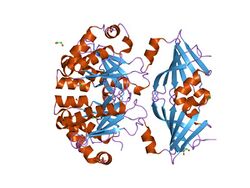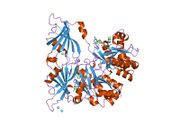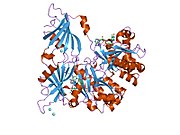Biology:DCPS (gene)
 Generic protein structure example |
| Scavenger mRNA decapping enzyme (DcpS) N-terminal | |||||||||
|---|---|---|---|---|---|---|---|---|---|
 crystal structure of mrna decapping enzyme (dcps) from mus musculus at 1.83 a resolution | |||||||||
| Identifiers | |||||||||
| Symbol | DcpS | ||||||||
| Pfam | PF05652 | ||||||||
| InterPro | IPR008594 | ||||||||
| SCOP2 | 1st4 / SCOPe / SUPFAM | ||||||||
| |||||||||
| Scavenger mRNA decapping enzyme C-term binding | |||||||||
|---|---|---|---|---|---|---|---|---|---|
| Identifiers | |||||||||
| Symbol | DcpS_C | ||||||||
| Pfam | PF11969 | ||||||||
| Pfam clan | CL0265 | ||||||||
| SCOP2 | 1st4 / SCOPe / SUPFAM | ||||||||
| |||||||||
Scavenger mRNA-decapping enzyme DcpS is a protein that in humans is encoded by the DCPS gene.[1][2][3]
The scavenger mRNA decapping enzymes include Dcp2 and DcpS. DcpS is a scavenger pyrophosphatase that hydrolyses the residual cap structure following 3' to 5' mRNA degradation. DcpS uses cap dinucleotides or capped oligonucleotides as substrates to release m(7)GMP (N7-methyl GMP), while Dcp2 uses capped mRNA as a substrate in order to hydrolyse the cap to release m(7)GDP (N7-methyl GDP).[4] The association of DcpS with 3' to 5' exonuclease exosome components suggests that these two activities are linked and there is a coupled exonucleolytic decay-dependent decapping pathway. The family contains a histidine triad (HIT) sequence in its C-terminal domain, with three histidines separated by hydrophobic residues.[5] The central histidine within the DcpS HIT motif is critical for decapping activity and defines the HIT motif as a new mRNA decapping domain, making DcpS the first member of the HIT family of proteins with a defined biological function.
See also
References
- ↑ "The scavenger mRNA decapping enzyme DcpS is a member of the HIT family of pyrophosphatases". EMBO J 21 (17): 4699–4708. Aug 2002. doi:10.1093/emboj/cdf448. PMID 12198172.
- ↑ "DcpS can act in the 5'-3' mRNA decay pathway in addition to the 3'-5' pathway". Proc Natl Acad Sci U S A 100 (21): 12081–12086. Oct 2003. doi:10.1073/pnas.1635192100. PMID 14523240. Bibcode: 2003PNAS..10012081V.
- ↑ "Entrez Gene: DCPS decapping enzyme, scavenger". https://www.ncbi.nlm.nih.gov/sites/entrez?Db=gene&Cmd=ShowDetailView&TermToSearch=28960.
- ↑ "Decapping the message: a beginning or an end". Biochem. Soc. Trans. 34 (Pt 1): 35–8. February 2006. doi:10.1042/BST20060035. PMID 16246173.
- ↑ "Crystal structure of an Apo mRNA decapping enzyme (DcpS) from Mouse at 1.83 A resolution". Proteins 60 (4): 797–802. September 2005. doi:10.1002/prot.20467. PMID 16001405.
Further reading
- "Oligo-capping: a simple method to replace the cap structure of eukaryotic mRNAs with oligoribonucleotides". Gene 138 (1–2): 171–174. 1994. doi:10.1016/0378-1119(94)90802-8. PMID 8125298.
- Suzuki Y; Yoshitomo-Nakagawa K; Maruyama K et al. (1997). "Construction and characterization of a full length-enriched and a 5'-end-enriched cDNA library". Gene 200 (1–2): 149–156. doi:10.1016/S0378-1119(97)00411-3. PMID 9373149.
- Zhang QH; Ye M; Wu XY et al. (2001). "Cloning and functional analysis of cDNAs with open reading frames for 300 previously undefined genes expressed in CD34+ hematopoietic stem/progenitor cells". Genome Res. 10 (10): 1546–1560. doi:10.1101/gr.140200. PMID 11042152.
- "Functional link between the mammalian exosome and mRNA decapping". Cell 107 (6): 751–762. 2002. doi:10.1016/S0092-8674(01)00592-X. PMID 11747811.
- Strausberg RL; Feingold EA; Grouse LH et al. (2003). "Generation and initial analysis of more than 15,000 full-length human and mouse cDNA sequences". Proc. Natl. Acad. Sci. U.S.A. 99 (26): 16899–16903. doi:10.1073/pnas.242603899. PMID 12477932. Bibcode: 2002PNAS...9916899M.
- Kwasnicka DA; Krakowiak A; Thacker C et al. (2003). "Coordinate expression of NADPH-dependent flavin reductase, Fre-1, and Hint-related 7meGMP-directed hydrolase, DCS-1". J. Biol. Chem. 278 (40): 39051–39058. doi:10.1074/jbc.M306355200. PMID 12871939.
- Ota T; Suzuki Y; Nishikawa T et al. (2004). "Complete sequencing and characterization of 21,243 full-length human cDNAs". Nat. Genet. 36 (1): 40–45. doi:10.1038/ng1285. PMID 14702039.
- Gu M; Fabrega C; Liu SW et al. (2004). "Insights into the structure, mechanism, and regulation of scavenger mRNA decapping activity". Mol. Cell 14 (1): 67–80. doi:10.1016/S1097-2765(04)00180-7. PMID 15068804.
- Liu SW; Jiao X; Liu H et al. (2004). "Functional analysis of mRNA scavenger decapping enzymes". RNA 10 (9): 1412–1422. doi:10.1261/rna.7660804. PMID 15273322.
- Gerhard DS; Wagner L; Feingold EA et al. (2004). "The status, quality, and expansion of the NIH full-length cDNA project: the Mammalian Gene Collection (MGC)". Genome Res. 14 (10B): 2121–2127. doi:10.1101/gr.2596504. PMID 15489334.
- "The 'scavenger' m7GpppX pyrophosphatase activity of Dcs1 modulates nutrient-induced responses in yeast". Nucleic Acids Res. 32 (12): 3590–3600. 2004. doi:10.1093/nar/gkh687. PMID 15240832.
- Chen N; Walsh MA; Liu Y et al. (2005). "Crystal structures of human DcpS in ligand-free and m7GDP-bound forms suggest a dynamic mechanism for scavenger mRNA decapping". J. Mol. Biol. 347 (4): 707–718. doi:10.1016/j.jmb.2005.01.062. PMID 15769464.
- "Role of a novel dual flavin reductase (NR1) and an associated histidine triad protein (DCS-1) in menadione-induced cytotoxicity". Biochem. Biophys. Res. Commun. 336 (2): 565–571. 2005. doi:10.1016/j.bbrc.2005.08.129. PMID 16140270.
- "Dcs2, a novel stress-induced modulator of m7GpppX pyrophosphatase activity that locates to P bodies". J. Mol. Biol. 363 (2): 370–382. 2006. doi:10.1016/j.jmb.2006.08.015. PMID 16963086.
External links
- PDBe-KB provides an overview of all the structure information available in the PDB for Human m7GpppX diphosphatase (DCPS)
 |





